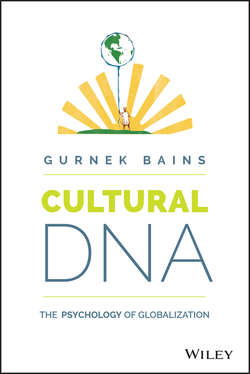Читать книгу Cultural DNA - Bains Gurnek - Страница 7
На сайте Литреса книга снята с продажи.
Introduction
Unconscious Bias
ОглавлениеFew people nowadays would openly serve up the kind of fare that Mortimer offers her readers. However, as the whole field of unconscious bias in psychology has uncovered, even people who are openly and vehemently against anything that smacks of stereotyping often show evidence of intergroup bias when their behavior is examined more closely. A legion of studies have demonstrated that when one looks at people's actual behavior and decision making, or aspects of their reactions they cannot control, they do hold profound views about intergroup differences. If, for example, white people are shown on a computer screen positive and negative adjectives, each paired with a white or ethnic sounding name and asked to say whether the adjective is good or bad, they show much faster reaction times when the positive adjective is paired with a white sounding name or the negative ones with the ethnic sounding name. When the pairing violates people's internal stereotypes, by putting positive adjectives next to ethnic sounding names or negative ones next to white-sounding names, the brain takes time to orient itself to this unexpected reality.6
In fact, a range of research looking at things people cannot control, such as reaction times, recall, or neuropsychological responses, shows that people hold unconscious biases not just toward other ethnic groups but also with respect to gender and all manner of other groupings in our social world. The differences are higher typically in people who are openly discriminatory in their thinking, but also invariably show up with even the most ardent liberals.7
So just because people don't like to flaunt their views Mortimer-style these days – this does not mean they do not hold underlying views about group differences. However, before we jump to the conclusion that everyone is full of irrational stereotypes, there is an interesting twist to the unconscious bias data. Black people in the earlier example also show evidence of holding the same biases, but a bit less strongly. In fact, a whole host of research on both conscious and unconscious stereotypes shows that often, but not always, the group itself shares the views that others hold about them. In general, while people differ in the values they attach to particular qualities – generally valuing the traits they possess over those with which they are less associated – they nevertheless often agree on what qualities their own and other groups possess. Why should this be so? Is there a conspiracy to envelop everyone with a global false consciousness to which we have all succumbed?
One strong strand within psychological research of group perceptions holds that some, but not all, stereotypes have a kernel of truth to them.8 There is strong evidence that people formulate views of other groups because of certain tangible bits of data and evidence rather than picking them out of thin air.9 It's a theory substantiated by the finding that many stereotypes seem to reflect people's observations of extreme or salient events. Simplistically, if you see a lot of Indian children in the Spelling Bee finals, you might think all Indians have a penchant for learning to spell complicated words. This is almost certainly a false view, but as will be discussed in the India chapter, there may be some cultural influences that drive success in such a competition for Indians. The stereotype is therefore both untrue and true at the same time. Stereotypes often arise from reading about different types of memorable events, portrayals of whiz kid geniuses, or quite simply the kinds of people who pop up on the TV. These extreme manifestations often do result from differences in the group mean of an attribute being skewed a bit – hence the kernel of truth notion.10
The unconscious bias research, plus the kernel of truth evidence, suggests that simply pretending there are no differences and that all views that express such views are infused with a false consciousness is quite simply trying to push psychological water uphill. Even if the conscious mind succumbs to the effort, the unconscious brain will most likely rebel. A much better course of action is to recognize the reality of some variations, but to try to get people to value differences more – that is, encourage them to more actively examine their models of what is good or necessary for success. This is where unconscious bias can really lead to a false consciousness and cause leaders to fail to leverage the power of diversity. In fact, there is something of a paradox to some of the arguments around diversity. At one level proponents of such an agenda want to minimize any suggestion of difference; but at another level they also want to get people to value diversity more. The latter can only make sense if differences exist, and if people recognize and actively celebrate them.
6
S. L. Gaertner and J. P. McLaughlin, “Racial Stereotypes: Associations and Ascriptions of Positive and Negative Characteristics,” Social Psychology Quarterly 46 (1983): 23–30.
7
M. Lyubansky, “Studies of Unconscious Bias: Racism Not Always by Racists,” Psychology Today, April 25, 2012.
8
E. T. Protho and L. H. Melikian, “Studies in Stereotypes: V. Familiarity and the Kernel of Truth Hypothesis,” Journal of Social Psychology 41 (1955): 3–10.
9
C. F. Bond Jr., D. S. Berry, and A. Omar, “The Kernel of Truth in Judgments of Deceptiveness,” Basic and Applied Social Psychology 15 (1994): 523–534.
10
M. Rothbart, S. Fulero, C. Jensen, J. Howard, and P. Birell, “From Individual to Group Impressions: Availability Heuristics in Stereotype Formation,” Journal of Experimental Social Psychology 14 (1978): 237–255.
